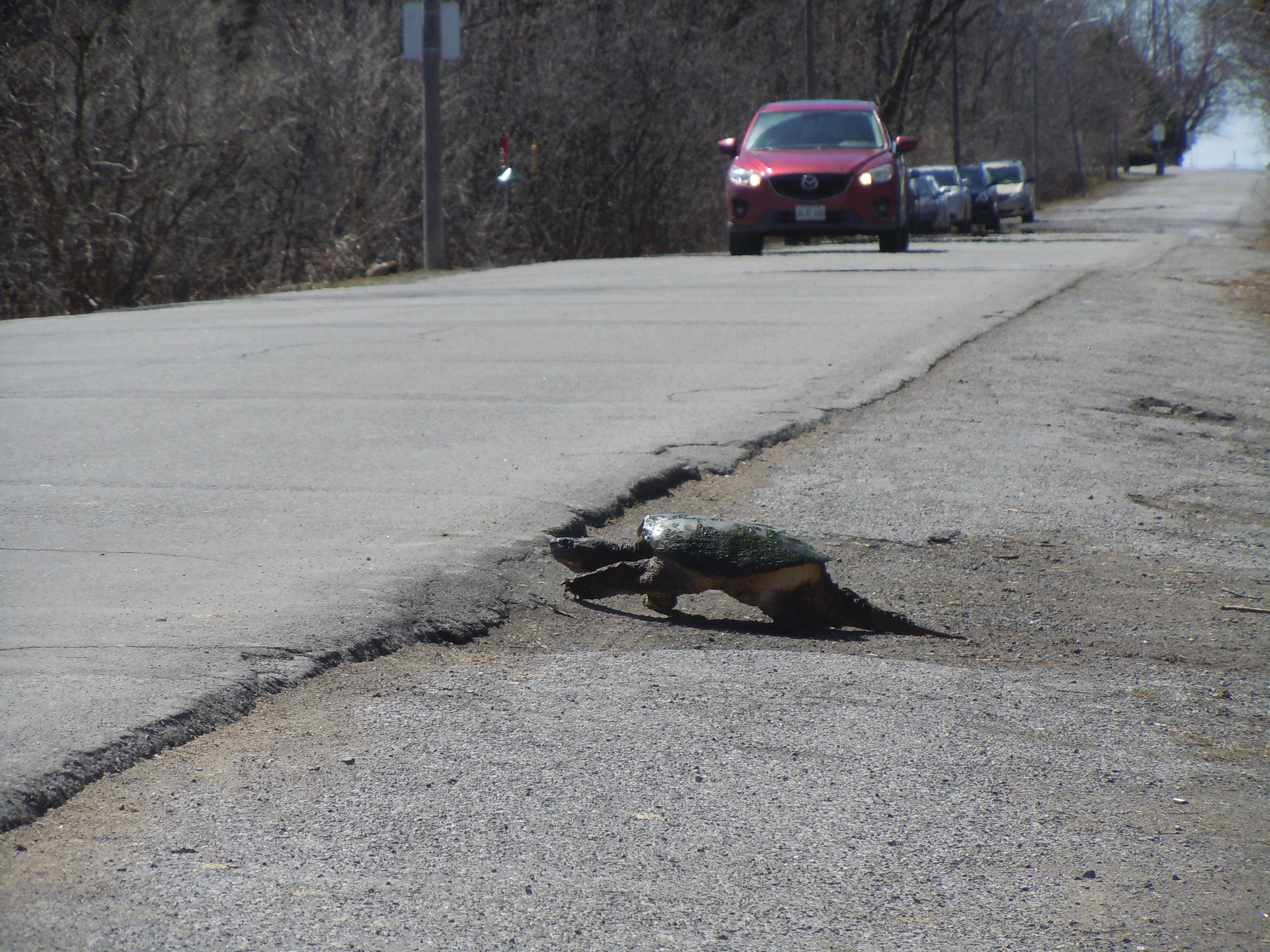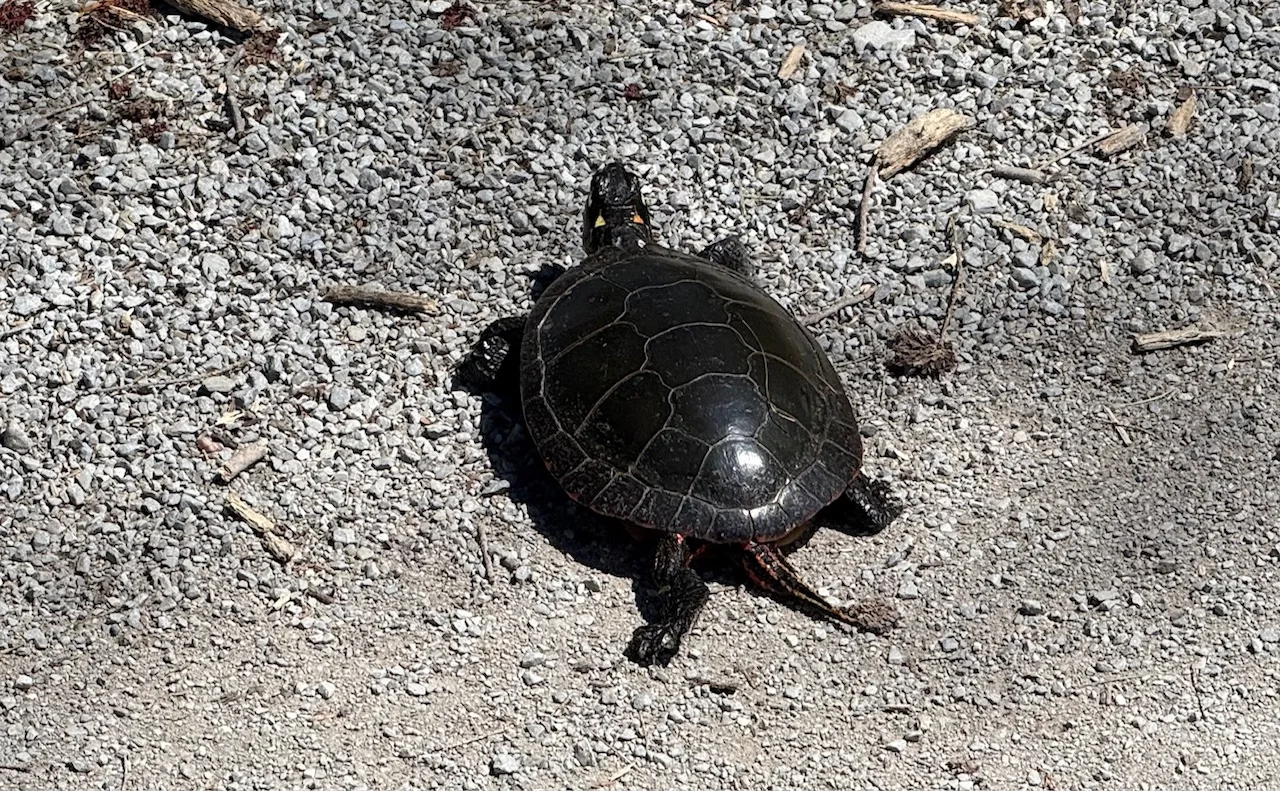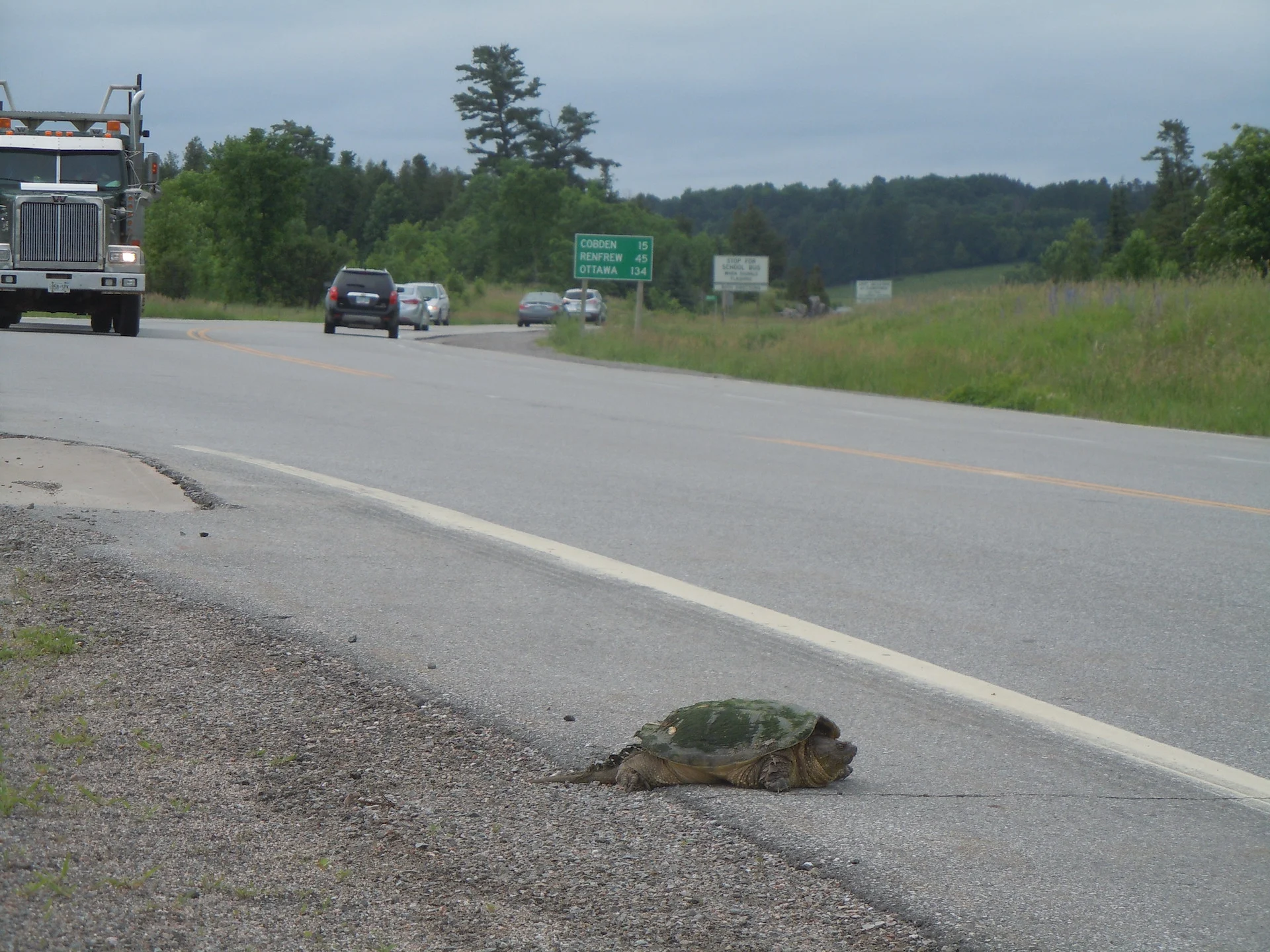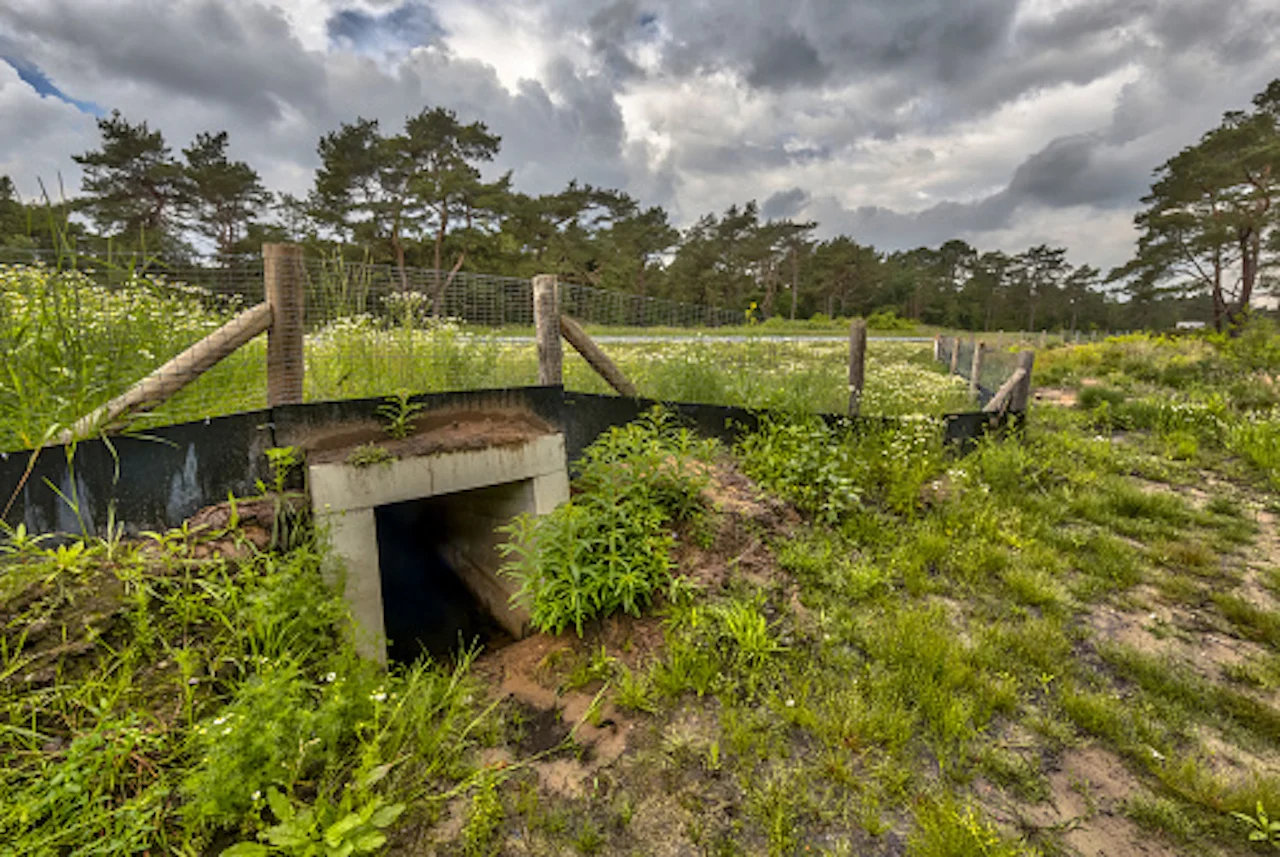
This can be a deadly time for one of Canada's 'most endangered' wildlife groups
With July nearly finished, freshwater turtles in Canada have finished laying eggs for the year, but they can still encounter danger from vehicle traffic while moving from one wetland to another.
While freshwater turtles in Canada have finished laying eggs, they are still likely to encounter danger from vehicle traffic as they remain mobile near roadside areas.
Preventing turtle mortality is particularly important because it can take up to two decades, or even longer, for some female species to reproduce. Conserving turtle habitats and reducing road mortalities can go a long way in securing their populations in Canada.
SEE ALSO: How we can help Canada's at-risk turtles survive and thrive
Canada has eight species of freshwater turtle and all of them are listed as at risk by the federal government, making them "one of the most endangered groups" of wildlife in the country, says David Seburn, a freshwater turtle specialist with the Canadian Wildlife Federation (CWF).
"Turtles are [still] on the move, and of course, human beings are on the move, as well. We've gotten over a long winter. People are heading to the cottage, they're heading out to the beach, and there are all kinds of cars on the roads. Those two things don't interact very well when you have turtles and cars on the roads at the same time," said Seburn, in a late-May interview with The Weather Network.

Painted turtle. (Nathan Howes/The Weather Network)
"Every time she crosses a road, there is a risk of being hit and killed by a vehicle, especially if the roads are very, very busy."
Road mortality is high
While there are numerous reasons for the decline of turtles, road mortality is one of the major threats. It is the No. 1 concern from late May to July as this is the time period when female turtles leave waterways to look for places to lay their eggs on land, often forcing them to cross roads to do so.
Because of that, the CWF is encouraging people to report observations of turtles (alive or dead) on roads to iNaturalist. Roads are a main threat to many species of turtle, and knowing where they cross them can help plan where mitigation should be placed, CWF said.
When turtles look for nesting sites, they will have particular habitat features they're looking for, Seburn said. In general, they want to leave the wetland, river or lake and move a certain distance from the water. Sometimes it's very close, 10 or 20 metres from the water, but, in other cases, it might be 100 or 200 metres away from it.
"Once they found an area they think is interesting, in general, they want a few important aspects, one of which is the full sun, so that way the ground will get the warmth, and the eggs in the ground will warm up, [with] not too much vegetation growing on the ground," said Seburn.
Turtles will avoid making nests in vegetative landscapes such as residential lawns because the grass makes it hard to dig, he said. So, they often opt for sandy beaches and soft surfaces that lack plants growing on or around them.
In "our modern age," one of the habitat features that adequately meets the turtles' needs for nesting are road shoulders, Seburn added.

Snapping turtle. (David Seburn/Canadian Wildlife Federation/Submitted to The Weather Network)
"If you think about it, the road is typically in full sun. That shoulder doesn't have vegetation growing on it, close to the road," said Seburn. "Typically, it's gravel, and the turtles can get there. It meets their criteria; sunshine, not too many plants, and they can dig and lay their eggs at the side of the road."
Are turtle-crossing signs helpful?
That, however, puts the turtles at risk while they're laying their eggs, especially if they cross the road.
Many locales in the country have turtle-crossing signs, but how effective are they?
"It's a good question. There have been a few studies on crossing signs for wildlife in general. They probably don't have as much effect as we would like them to have," said Seburn.

Turtle-crossing sign in Merrickville, Ont. (Getty Images/mirjana simeunovich/1058611822-170667a)
He noted that many drivers have "lots on their minds" and some may not be paying attention to every road sign, especially if it says turtle crossing.
"You glance around [and] you don't see a turtle. Maybe next time you would, but if you drive that route a few times and never see a turtle, it kind of reinforces the message that perhaps this sign isn't telling you important information," said Seburn. "I think a lot of people are just seeing too many signs, and they can't pay attention to them all."
However, Seburn said the signs may still help a bit, particularly in locations where the maximum road speed is not very high, so people have more time to react if they do see something on the road.

Snapping turtle about to cross the road. (Canadian Wildlife Federation (CWF)/Submitted to The Weather Network)
"Signs are one thing that can flag people's attention, but they may not be the most effective way," said Seburn.
Infrastructure to assist turtles
Ecological passages, known as wildlife corridors or ecoducts, are different physical mediums that connect areas to provide safe passages for animals. There are land and water corridors--from highway overpasses and underpasses to culverts.
In the case of turtles, an effective way to protect turtles attempting to cross the road would be to install wildlife fencing, which needs to be erected along the road shoulder "in tandem" with a type of structure under or above the road that allows them to cross it safely, Seburn explained.

Wildlife passage. (Getty Images/IHervas/639025526-170667a)
"Frequently, that can be as simple as a standard drainage culvert that we've probably all seen driving in rural areas. Typically, it's a corrugated steel pipe. It's round, maybe it's about a metre in diameter, sometimes a bit smaller, sometimes bigger, but it allows anything to cross through," said Seburn.
He noted, however, that if there is open access or if it's completely flooded with water, it won't work. The good news is that by June, most culverts "I've seen typically don't have very much water in them."
"It would allow turtles and other wildlife to cross under the road and get to the other side.You might think that the culvert alone should be sufficient, but for the most part, most species will avoid going into a dark hole in the ground, even if they can see light on the other side," said Seburn.
But, if you pair that with the fencing, it will guide the turtle and other wildlife to that culvert, Seburn added.

Wildlife passage. (Getty Images/CreativeNature_nl/871409458-170667a)
"Without the fencing, they're going to go up onto the road, try to cross the road, and they may or may not be successful," said Seburn.
How to move a turtle safely, and to safety
There are a number of things people can do to try to help turtles circumvent dangerous traffic. The CWF has a list of tips on moving turtles safely since there are proper steps to follow.
As you're driving in a rural area, if you see a live turtle on the road and it's trying to cross that road--and if it's safe to do so--you can pull off to the shoulder and move that turtle in the direction or location it was travelling to, Seburn said.
"You [have] to be very careful that it's safe to do so. But for most turtles, [they're] fairly simple to pick up," said Seburn. "I recommend using both hands, one on each side of the turtle, and then just carrying it across the road in the direction it's heading."

Snapping turtle along the side of the road. (Canadian Wildlife Federation (CWF)/Submitted to The Weather Network)
If it's a snapping turtle, however, "that's a very different story," he said.
"Snapping turtles do not want to be picked up. They have a wicked bite. They are not aggressive. They're not going to attack you, but they are very defensive, and they do not like anyone getting too close to them, particularly on land," said Seburn.
The CWF freshwater turtle specialist doesn't recommend people attempt to move a snapping turtle on a heavily trafficked road if they've never handled one before, he said.
"In that case, sometimes you might be able to find something in your car, like an old blanket, maybe a shovel. [With] an old blanket, you can toss it over the snapping turtle and just drag it off the road," said Seburn. "It's not the most elegant solution, but it's far better for the turtle than being hit by a car."

Moving a Blanding's turtle off the road. (Canadian Wildlife Federation (CWF)/Submitted to The Weather Network)
It can take 15 to 20 years for a snapping turtle hatchling to grow up and be old enough to lay eggs, which is "a very, very long time," said Seburn. So, it takes a long time for each generation to be produced, age and join the adult population.
"You don't have to be paranoid about hitting a turtle all the time, but certainly, if you're in particularly rural areas where you're close to water--whether it's a river, lake or wetlands--it's a good idea to at least keep it in the back of your mind that there could be turtles moving about, and if possible, to avoid them," said Seburn.
WATCH: Urban turtles need our help, send in the Turtle Troopers!
Thumbnail courtesy of the Canadian Wildlife Federation/Submitted to The Weather Network.
